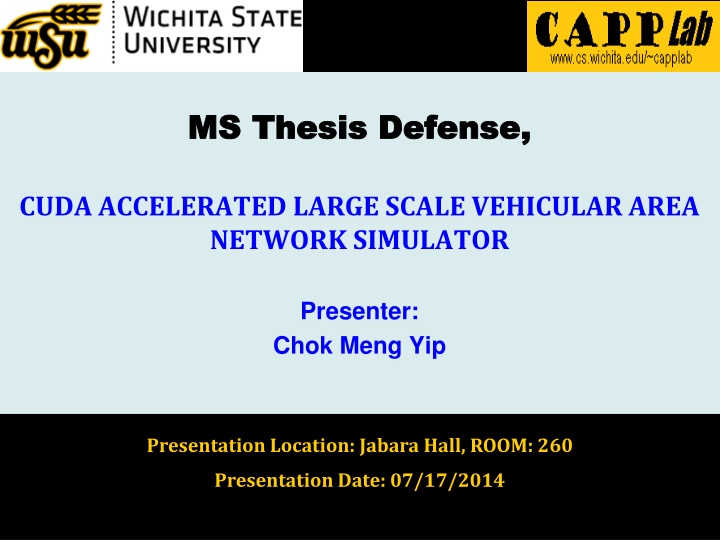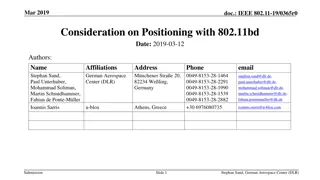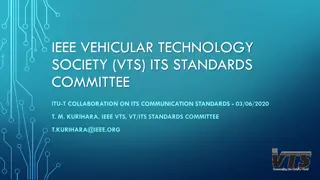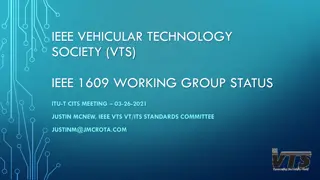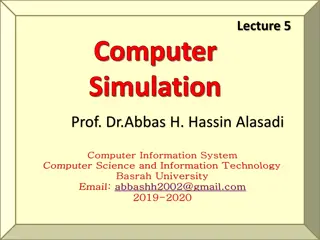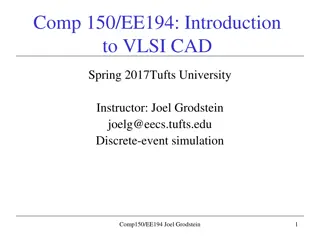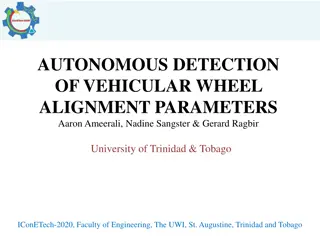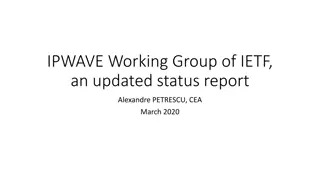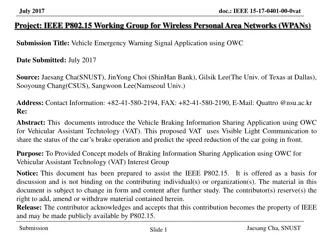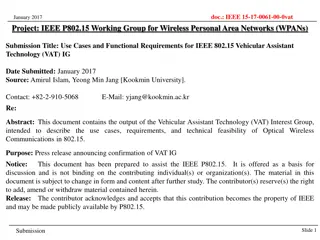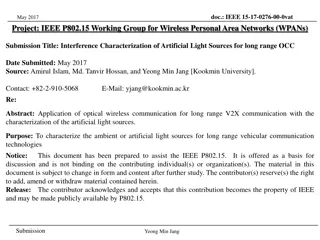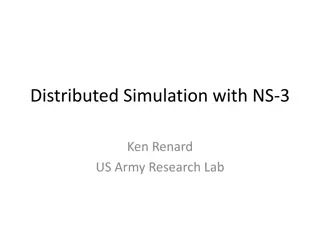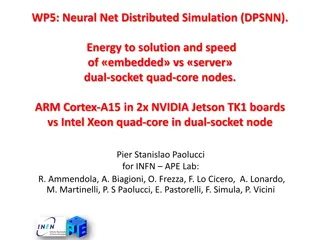Vehicular Area Network Simulation Study
This presentation focuses on a CUDA-accelerated large-scale vehicular area network simulator developed by Chok Meng Yip for his MS thesis defense. The study explores wireless networking technologies, VANET applications like accident prevention, and the physical layer of wireless communication. Chok Meng Yip's research covers topics such as modulation, medium access control, driving behavior modeling, and more.
Download Presentation

Please find below an Image/Link to download the presentation.
The content on the website is provided AS IS for your information and personal use only. It may not be sold, licensed, or shared on other websites without obtaining consent from the author.If you encounter any issues during the download, it is possible that the publisher has removed the file from their server.
You are allowed to download the files provided on this website for personal or commercial use, subject to the condition that they are used lawfully. All files are the property of their respective owners.
The content on the website is provided AS IS for your information and personal use only. It may not be sold, licensed, or shared on other websites without obtaining consent from the author.
E N D
Presentation Transcript
MS Thesis Defense, MS Thesis Defense, CUDA ACCELERATED LARGE SCALE VEHICULAR AREA NETWORK SIMULATOR Presenter: Chok Meng Yip Presentation Location: Jabara Hall, ROOM: 260 Presentation Date: 07/17/2014
About Me I am Chok Meng Yip, majoring in Computer Networking with thesis under Dr. Abu Asaduzzaman Lab Assistant at CAPPLab Embedded Systems Parallel Programming Co-author of publications: An effective CUDA based simulation for lightning strike protection on nanocomposite materials in Southeastcon 2013 Fast Effective Deterministic Primality Test Using CUDA/GPGPU , in International Journal of Computers & Technology (IJCT), Vol. 12, No. 3, pp. 3738-3746, Jan. 2014. CUDA/C Based Green Technology for Very Fast Analysis of Nanocomposite Properties, in SAMPE Tech 2013 Conference, Wichita, Kansas, Oct. 21-24, 2013. Fast, Effective, and Adaptable Computer Modeling and Simulation of Lightning Strike Protection on Composite Materials, in IEEE SoutheastCon Conference 2013, Jacksonville, Florida, April 4-7, 2013. A Promising CUDA-Accelerated Vehicular Area Network Simulator Using NS-3, under review, in 33rd IEEE International Performance Computing and Communications Conference (IPCCC), Austin, TX, Dec. 5-7, 2014. Chok Meng Yip 2
Improved VANET Simulator Outline Q U E S T I O N S ? Any time, please. Introduction Motivation Proposal Evaluation Results Conclusions Chok Meng Yip 3
Introduction Vehicular Area Networking (VANET) Wireless Networking Technologies Physical Layer Medium Access Control 802.11p Mobility Modelling Vehicular Area Networks Types Driving Behavior Applications Accident prevention Chok Meng Yip 4
Wireless Networking Wireless Networking Physical Layer Modulation Encode Demodulation Decode Signal Modulation[1] Digital <-> Analog Chok Meng Yip 5
Wireless Networking (+) Wireless Networking (+) Physical Layer (+) Signal-Noise Ratio SNR <-> Bit Rate Signal Modulation[1] Distance Fixed Frequency Chok Meng Yip 6
Wireless Networking (+) Wireless Networking (+) Medium Access Control Medium Access Control Coordinates nodes Medium Sharing High usage Distributed Coordinated Function[2] Chok Meng Yip 7
Wireless Networking (+) Wireless Networking (+) IEEE 802.11p IEEE 802.11p Intelligent Transportation System 802.11p 5.8Ghz Allocated 75Mhz Service Channels Control Channels Frequency (Ghz) Channel Number Usage 5.850 5.860 5.870 5.880 5.890 5.900 5.910 5.920 172 174 176 178 180 182 184 Spacing Critical Safety Service Channels Control Channel Service Channels Public Safety Chok Meng Yip 8
Introduction Introduction Mobility Modelling Driving Behavior Acceleration Treiber Intelligent Driving Model V current velocity V0 intended velocity Lane Change Merits Politeness Chok Meng Yip 9
Introduction Introduction Applications Influence Driving Behavior Beyond visible range Line of sight Communication Types V2V V2I V2x Chok Meng Yip 10
Wireless Networking Wireless Networking Applications-An Example 1.Vehicle Breakdown 2.Driver Alerted 3.Driver Informs to Change Lane Chok Meng Yip 11
CUDA ACCELERATED LARGE SCALE CUDA ACCELERATED LARGE SCALE VEHICULAR AREA NETWORK SIMULATOR VEHICULAR AREA NETWORK SIMULATOR Outline Q U E S T I O N S ? Any time, please. Introduction Motivation Proposal Evaluation Experimental Results Conclusion Chok Meng Yip 12
Motivation Optimize Network Performance Simulation MAC Signal Strength Placement of Nodes Data dissemination Chok Meng Yip 13
Problem Statement Simulators Current Available Technology MoVes Distributed Systems Many Computers Expensive Moritz Mathematical Optimization 15% Less accurate Traditional Simulator Slow Chok Meng Yip 14
Problem Statement NS-3 Simulator Open Source Accurate Models Weingartner et.al [3] -Fastest Simulator OMNet++ GUI Baseline NCTuns GUI + Backend Fast NS-3 Backend Only Fastest Implementation Simulation Speed [3] Source Model Open Closed Closed Chok Meng Yip 15
Problem Statement NS-3 VANET Simulator Event based simulator Hadi Arbabi & Michelle Wiegle Models Treiber IDM NS-3 Wireless Stack NS-3 Modules Chok Meng Yip 16
CUDA ACCELERATED LARGE SCALE CUDA ACCELERATED LARGE SCALE VEHICULAR AREA NETWORK SIMULATOR VEHICULAR AREA NETWORK SIMULATOR Outline Q U E S T I O N S ? Any time, please. Introduction Motivation Proposal Evaluation Experimental Results Conclusion Chok Meng Yip 17
Traditional Simulator Vehicular Modelling Stores data in Linked List No easy parallelization method Computationally Expensive Chok Meng Yip 18
Proposed Simulator Proposed NS-3 Simulator Initialization Position Matrix Velocity Matrix Iteration Acceleration Apply Matrix Copy Distance Chok Meng Yip 19
Proposed Simulator (+) CUDA NS-3 VANET Simulator Change Data structure to Matrix Collect all data before computing GPU to speed up Many Cores Same Equation Chok Meng Yip 20
CUDA CUDA GPGPU Compute Unified Device Architecture SIMD Device memory Divide Data into Grid Block Threads Shared Memory for each block Programmers (Logical) perspective Chok Meng Yip 21
Proposed Simulator (+) Position Matrix Easy to Compute for GPU Easy to retrieve from CPU Pt[0] Position of node 0 Chok Meng Yip 23
Proposed Simulator (+) Distance Matrix Computes distance between all nodes Performed in GPU __global__ void computeDistanceMatrix(Vector3D *a, Vector3D *b, double *c, int numberOfNodes){ .. if ( (i<numberOfNodes) && (j < numberOfNodes)){ c[i*numberOfNodes + j] = sqrt(dx*dx + dy*dy + dz*dz); } } Chok Meng Yip 24
Proposed Simulator (+) Proposed NS-3 Simulator Uses same input Generates same output Wireless: Only need Distance between nodes Chok Meng Yip 25
CUDA ACCELERATED LARGE SCALE CUDA ACCELERATED LARGE SCALE VEHICULAR AREA NETWORK SIMULATOR VEHICULAR AREA NETWORK SIMULATOR Outline Q U E S T I O N S ? Any time, please. Introduction Motivation Proposal Evaluation Experimental Results Conclusion Chok Meng Yip 26
Evaluation Correctness P0 initial position M0 initial movement P1 after first iteration D1 distance after 5 iterations P5 after 5 iteration Chok Meng Yip 27
Evaluation Compare to CPU Node Number Node 1 Node 2 Node 3 Node4 Node 5 X position Before 1 3 5 7 9 Y position Before 1 1 1 1 1 After 16 21 23 25 27 After 1 1 1 1 1 Same result as CPU Chok Meng Yip 28
CUDA ACCELERATED LARGE SCALE CUDA ACCELERATED LARGE SCALE VEHICULAR AREA NETWORK SIMULATOR VEHICULAR AREA NETWORK SIMULATOR Outline Q U E S T I O N S ? Any time, please. Introduction Motivation Proposal Evaluation Experimental Results Conclusion Chok Meng Yip 29
Experimental Results Platforms Supercomputer AMD Opteron 6134 512KB 32 2.3 Ghz 64GB NVidia Tesla K20m Keper 0.71GHz 5GB 2496 Workstation Intel Xeon E5506 4096KB 8 2.13 Ghz 12GB NVidia Tesla C2075 Fermi 1.15GHz 6144MB 448 CPU CPU Cache Size Cores Clock Speed RAM Size GPU GPU Architecture GPU Core Clock GPU Memory Size GPU Cores Chok Meng Yip 30
Experimental Results Isolated Workload Chok Meng Yip 31
Experimental Results Isolated Workload Traditional Simulator Time increase Exponentially Proposed Simulator Minimal Time Increase 75x Speed up Chok Meng Yip 32
Experimental Results Isolated Workload Chok Meng Yip 33
Experimental Results Isolated Workload Traditional Simulator Time increases linearly Proposed Simulator Time increases by factor Chok Meng Yip 34
Experimental Results(+) Full Workload Chok Meng Yip 35
Experimental Results(+) Full Workload Proposed Converges to CPU Time Traditional Time increases linearly Chok Meng Yip 36
Experimental Results(+) Energy Consumption Energy Consumption- - Isolated Workload Isolated Workload Isolated Workload- Energy vs Number of Nodes 60 50 40 Energy (kJ) 30 Traditional Proposed 20 10 0 10 15 20 25 Number of 1000 Nodes 30 35 40 45 50 55 Traditional Exponential increase Proposed Small Factor increase Chok Meng Yip 37
Experimental Results(+) Energy Consumption Energy Consumption- - Isolated Workload Isolated Workload Traditional Linear increase Proposed Exponential Increase Chok Meng Yip 38
CUDA ACCELERATED LARGE SCALE CUDA ACCELERATED LARGE SCALE VEHICULAR AREA NETWORK SIMULATOR VEHICULAR AREA NETWORK SIMULATOR Outline Q U E S T I O N S ? Any time, please. Introduction Motivation Proposal Evaluation Experimental Results Conclusion Chok Meng Yip 39
Conclusion VANET is a complex system Simulation assists network designers to design VANET network VANET is computationally expensive due to complexity Chok Meng Yip 40
Conclusion (+) By modifying the NS-3 data-structure, we can parallelize the process Using NVIDIA CUDA, we achieve up 75x speed up Data-Dependency on CPU Enhance more modules to reduce dependence on CPU Chok Meng Yip 41
Future Extensions Enhance NS-3 Modules: Further improve VANET simulator throughput by using CUDA in more modules Self Optimizing Simulator: Simulator optimize input parameters by using output as feedback. Data Regrouping: Improve CUDA effectiveness by using data regrouping based on locality principle. Chok Meng Yip 42
Questions? Chok Meng Yip 43
CUDA ACCELERATED LARGE SCALE VEHICULAR AREA NETWORK SIMULATOR Thank you. Thank you. Chok Meng Yip cxyip1@wichita.edu Chok Meng Yip 44
References 1. Gronemeyer, Steven A., and Alan L. McBride. "MSK and offset QPSK modulation." Communications, IEEE Transactions on 24, no. 8 (1976): 809-820. 2. Bianchi, Giuseppe. "Performance analysis of the IEEE 802.11 distributed coordination function." Selected Areas in Communications, IEEE Journal on 18, no. 3 (2000): 535-547. Chok Meng Yip 45
